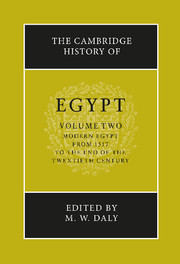Book contents
- Frontmatter
- 1 Ottoman Egypt, 1525–1609
- 2 Egypt in the seventeenth century
- 3 Egypt in the eighteenth century
- 4 Culture in Ottoman Egypt
- 5 The French occupation of Egypt, 1798–1801
- 6 The era of Muhammad ’Ali Pasha, 1805–1848
- 7 Egypt under the successors of Muhammad ’Ali
- 8 The Egyptian empire, 1805–1885
- 9 The ‘Urabi revolution and the British conquest, 1879–1882
- 10 The British occupation, 1882–1922
- 11 Social and economic change in the “long nineteenth century”
- 12 The liberal age, 1923–1952
- 13 Egypt: society and economy, 1923–1952
- 14 Republican Egypt interpreted: revolution and beyond
- 15 Modern Egyptian culture in the Arab world
- Select Bibliography
- Index
- References
2 - Egypt in the seventeenth century
Published online by Cambridge University Press: 28 March 2008
- Frontmatter
- 1 Ottoman Egypt, 1525–1609
- 2 Egypt in the seventeenth century
- 3 Egypt in the eighteenth century
- 4 Culture in Ottoman Egypt
- 5 The French occupation of Egypt, 1798–1801
- 6 The era of Muhammad ’Ali Pasha, 1805–1848
- 7 Egypt under the successors of Muhammad ’Ali
- 8 The Egyptian empire, 1805–1885
- 9 The ‘Urabi revolution and the British conquest, 1879–1882
- 10 The British occupation, 1882–1922
- 11 Social and economic change in the “long nineteenth century”
- 12 The liberal age, 1923–1952
- 13 Egypt: society and economy, 1923–1952
- 14 Republican Egypt interpreted: revolution and beyond
- 15 Modern Egyptian culture in the Arab world
- Select Bibliography
- Index
- References
Summary
Ottoman transformation and Egypt’s changing role
The seventeenth century was an era of momentous change for all provinces of the Ottoman empire, as the empire came to the end of the phase of continuous territorial expansion that had stretched from the mid-fifteenth century through the late sixteenth century. The end of this phase of expansion has until recently been construed as the onset of the Ottoman empire’s decline. A critical reexamination of the so-called decline paradigm, however, has led some historians of the Ottoman empire to abandon the notion of an imperial golden age under Sultan Sulayman I (1520–66), and to recast the course of Ottoman history in terms of a late sixteenth-century fiscal and military crisis followed by an adjustment of imperial priorities.
The crisis of the late sixteenth century changed the character of Ottoman military manpower and land tenure. Confronted with massive inflation, thought to have resulted at least in part from an influx of Spanish American silver, the imperial treasury debased the Ottoman silver currency (aqcha) and delayed the imperial troops’ salaries; consequently, soldiery revolts, in particular among the imperial Janissaries, became increasingly common. In the countryside, inflation combined with overpopulation to force land-holding cavalry officers and peasants off the land in what was dubbed the Great Flight. This upheaval coincided with a series of costly wars against the Hapsburgs (1593–1606) that ended in stalemate. To counter the Hapsburgs’ firepower, the Ottomans had armed peasants with rifles; in consequence, firearms spread throughout the countryside, enabling dispossessed landholders to turn to brigandage and to offer their services as mercenaries.
- Type
- Chapter
- Information
- The Cambridge History of Egypt , pp. 34 - 58Publisher: Cambridge University PressPrint publication year: 1998
References
- 4
- Cited by



